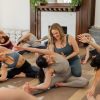
Ardha Chandrasana, translated as Half Moon Pose, has continuously been one of my favorite yoga poses to practice and teach over the last 20 years. It’s a great pose for beginner level students because it’s big and spacious, yet poses a challenge balancing on one leg. It also comes with the option of practicing with your back against a wall for additional stability or using a block under your bottom hand for support. For the more experienced practitioners, this pose can still offer nuances and insights as a foundational standing pose that you will probably practice thousands of times throughout your yogi journey. From straightening the legs fully or finding the backbending/heart-opening quality across the chest, this pose is a classic, and one that I revisit quite often.
For this sequence, focus on the outer hip of the standing leg firming inward to provide stability to the front leg. This alignment principle can be carried through many of the poses that show up in this sequence before Half Moon Pose, for example: Triangle pose, Extended Side Angle Pose, Warrior 2 Pose, and Tree Pose. In fact, classically this pose is entered via Triangle pose due to the many similarities of alignment.
One thing to think about when teaching Half Moon Pose is to build the pose from the ground up. Students are often too quick to lift their top arm or turn their gaze upward before the foundation of the pose is settled. After all, Half Moon is a standing pose. The foundation is the standing leg and bottom arm; the front leg needs to be fully straightened with the support of the outer hip and the bottom hand should be placed on the floor or block directly under the shoulder about a foot forward of the little toe. Getting the foundation situated first is one key to finding stability and spaciousness in this pose.
Here’s the sequence:
Puttering/Warm-Up
- Supta Padangusthasana A + B
- Downward Facing Dog
- Prasarita Padottanasana
- Side Plank prep w/ knee down
Standing Poses
- Triangle Pose
- Warrior 2
- Extended Side Angle
*Side Plank, which is not technically a standing pose, but is supportive of the arms and chest spreading.
Balance Pose
- Tree Pose
- Utthita Hasta Padangusthasana A + B
Peak Pose
- Ardha Chandrasana
Wind Down Poses
- Bharadvajasana 1
- Bridge Pose
Savasana
Give it a try and let us know how it goes! To catch a few video clips of this sequence in action follow @patrickfrancojr and @yogarenewteachertraining on Instagram.
And, if you want more in-depth vinyasa sequences like this along with teaching notes + tips on how to cue them, enter your email below to grab our FREE guide:







